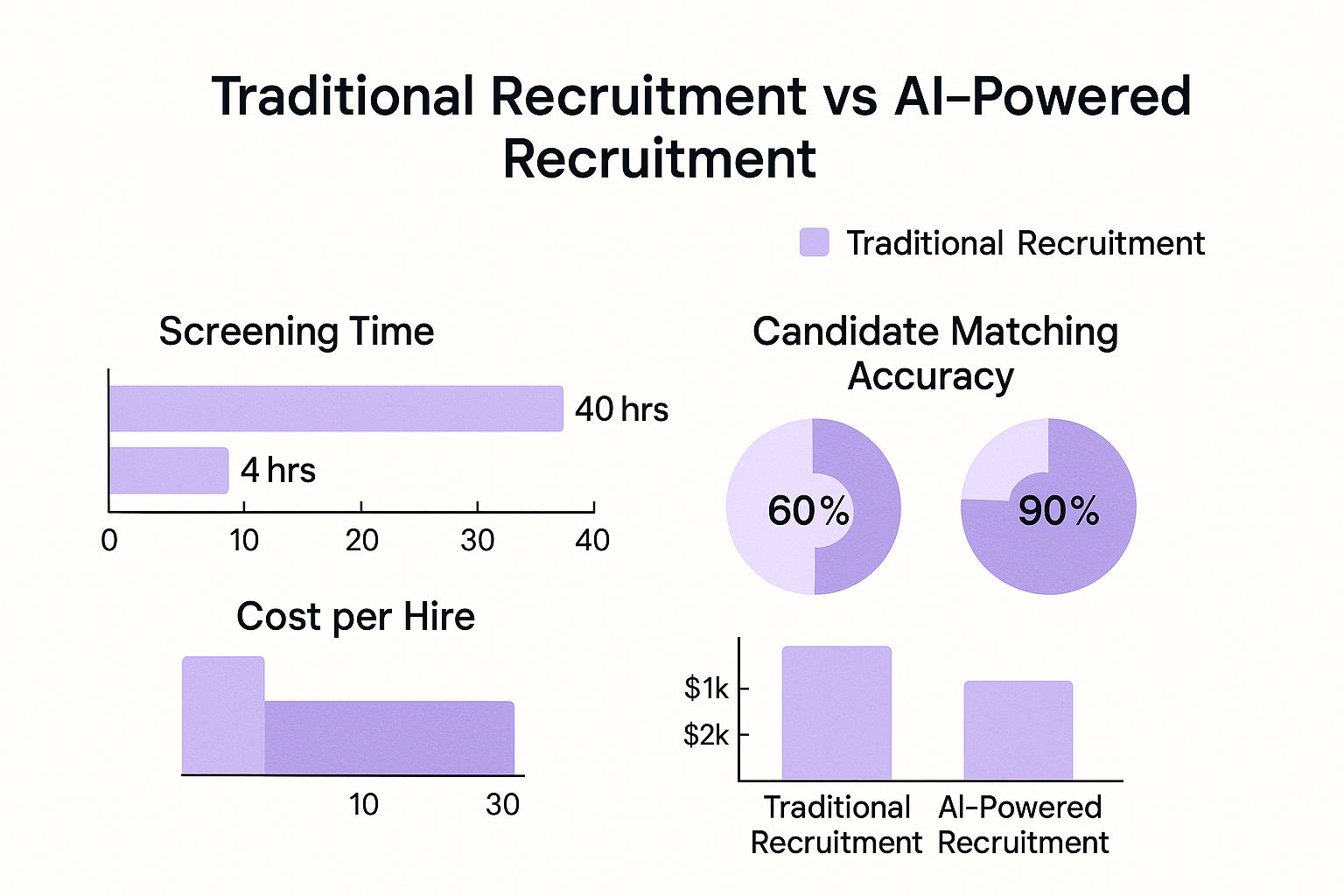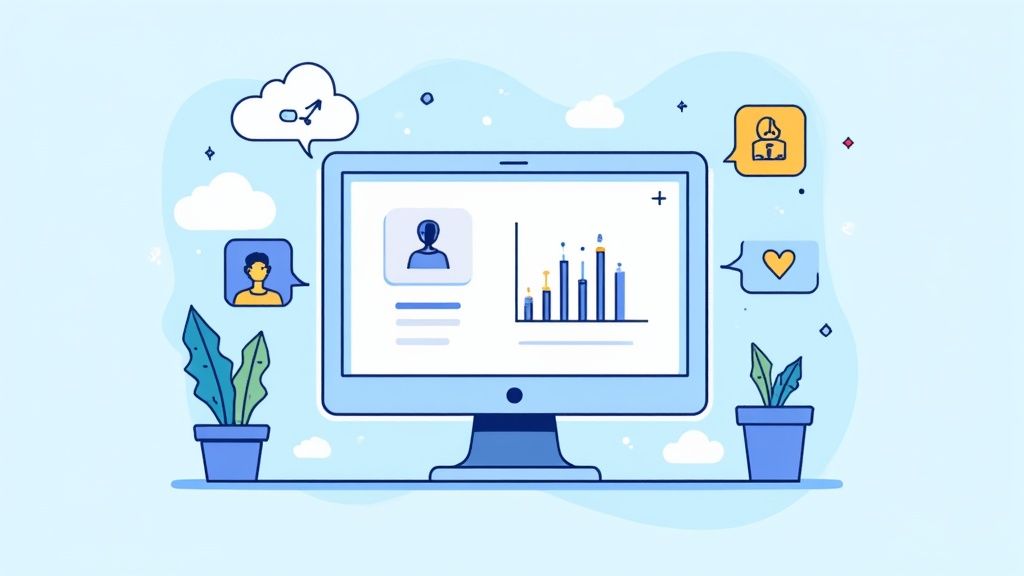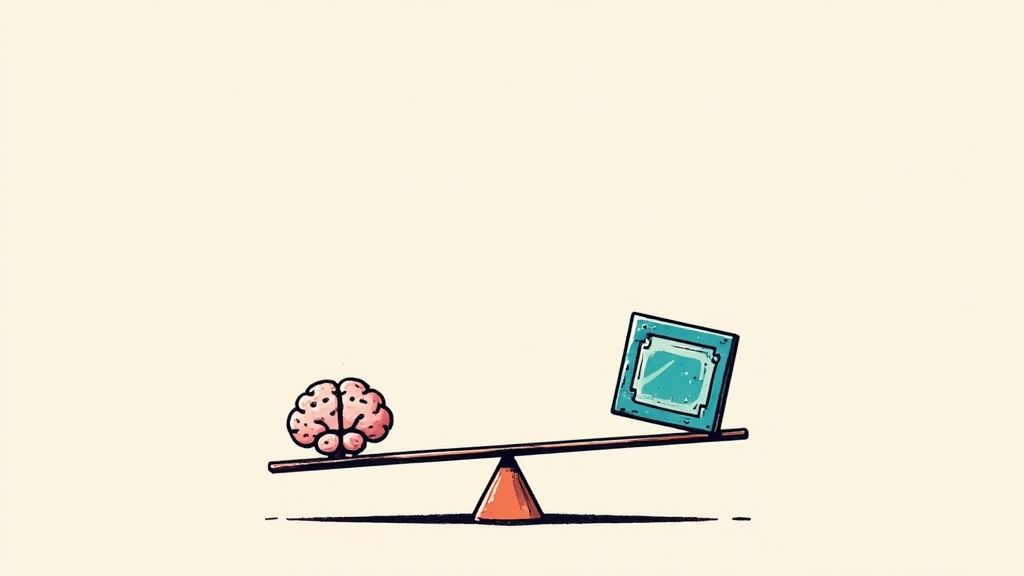
Let’s be honest, your hiring process is a time-sink. You're drowning in resumes, stuck in pointless interviews, and losing top candidates because your team is just too slow. This is where AI-powered recruitment tools step in, taking over the grunt work so you can focus on building your team, not your paperwork pile.
If you’ve ever found yourself scrolling through LinkedIn until your eyes glazed over, you know the pain. You post a job, and the floodgates open. You're hit with a tidal wave of applications—most of which are wildly unqualified—and your calendar fills up with interviews that go nowhere fast.
Hope you enjoy spending your afternoons fact-checking resumes and running technical interviews—because that’s now your full-time job. It’s a soul-crushing cycle of administrative quicksand that pulls you further away from what actually matters.
You're stuck playing defense, constantly reacting to the influx of noise instead of proactively seeking out the signal. The best candidates? They’re typically off the market in just 10 days. By the time you’ve waded through the first hundred applications, your top choice has already signed an offer with your competitor.
This isn't just frustrating; it's expensive. Every hour you spend on manual screening is an hour you aren't spending on growing the business. Every bad hire costs you time, money, and team morale. What we’re talking about is a system that’s fundamentally broken for growing companies that need to move fast and hire smart.
It's not you, it's the outdated system. Trying to win at modern hiring with old tools is like trying to win a Grand Prix in a horse-drawn buggy. You can whip the horses all you want, but you’re still going to lose.
The numbers don't lie. The data paints a clear picture of just how different the two approaches are.

As you can see, AI-powered recruitment tools don't just offer a slight improvement. They dramatically cut down screening time, improve match accuracy, and can slash the cost per hire in half.
To put it in perspective, let's break down how AI transforms the most painful parts of the hiring workflow.
| Hiring Task | Traditional Agony | AI-Powered Solution |
|---|---|---|
| Resume Screening | Manually reading hundreds of CVs, most of which are irrelevant. | Instantly parses and ranks candidates based on skills, experience, and custom criteria. |
| Candidate Sourcing | Posting on job boards and hoping for the best, or paying expensive headhunters. | Proactively finds passive candidates across platforms who fit your ideal profile. |
| Initial Interviews | Wasting hours on first-round calls with unqualified or uninterested candidates. | Uses chatbots and automated video interviews to handle initial screening 24/7. |
| Scheduling | Endless email chains trying to find a time that works for everyone. | Automates interview scheduling by syncing calendars and sending reminders. |
| Candidate Experience | Candidates are left in the dark for weeks, leading to frustration and drop-off. | Provides instant feedback, status updates, and a smooth, professional experience. |
The contrast is stark. One path leads to burnout and missed opportunities, while the other leads to faster, smarter, and more cost-effective hiring.
So, what's the alternative to this recruiting chaos? It’s not about working harder or throwing more recruiters at the problem. It’s about working smarter by adopting technology designed for this exact challenge.
You need a system that does the heavy lifting for you. A process that:
It’s time to stop brute-forcing a broken process and start using tools that give you your time—and your sanity—back.

Alright, let's cut through the marketing fluff. When you hear "AI-powered recruitment tools," don't picture a sentient robot stealing your job to interview candidates. Not yet, anyway.
Think of it this way: AI is the most efficient intern you've ever had. It never sleeps, never complains, and can sift through a mountain of data before you’ve finished your first cup of coffee. These tools are really just smart software platforms designed to automate the most mind-numbing, repetitive parts of hiring.
They’re the engine that takes a stack of 1,000 resumes and hands you the top 10, saving you from a weekend of soul-crushing administrative work.
So, how does this actually work? It boils down to a few core concepts that sound complex but are pretty straightforward in practice. You don't need a PhD from MIT to get it.
The secret sauce is a combination of a few key technologies:
This tech isn't here to replace your intuition. It’s here to give you better data so your intuition has more to work with.
Let's be clear: this is less about artificial intelligence and more about giving your team augmented intelligence. You’re still the pilot, but now you have a ridiculously advanced navigation system. The goal is to free you from the weeds so you can focus on the human side of hiring—building relationships, assessing cultural fit, and closing your top candidates.
An AI recruitment tool won't tell you if a candidate will be a great teammate. But it will give you a shortlist of five people who have the validated skills, relevant experience, and are actually available to talk, so you can spend your time finding out.
The market for these tools is exploding for a reason. In 2023, the global AI recruitment market was already valued at $661.56 million. Forecasts show it’s on track to hit $1.35 billion by 2025. Why? Because founders and hiring managers are realizing they can't afford not to use them.
This isn't just a niche for big tech companies anymore. It’s becoming standard practice for anyone who wants to hire top talent without burning out their team.
The same principles of automation and data analysis that streamline project management are what make AI-powered recruitment tools so effective. If you're curious about how AI is boosting efficiency in other areas, check out these top AI powered productivity tools. They’re all designed to do one thing: give you back your most valuable asset—time.

Let's get one thing straight: not all AI-powered recruitment tools are created equal. Some are just glorified keyword scanners wrapped in a slick, expensive interface. They’ll sell you on a "proprietary algorithm" that’s about as smart as a CTRL+F search.
You don't have time for gimmicks. You need technology that actually moves the needle, not just another dashboard to stare at. After kicking the tires on more tools than I can count, I’ve learned to separate the shiny objects from the true game-changers.
The real value isn’t in a fancy UI. It's in the features that automate the soul-crushing parts of your job and deliver a tangible return on your investment. We’re talking about a shortlist of qualified candidates landing in your inbox while you’re still brewing your morning coffee.
I once tested a sourcing tool that promised to find “hidden gem” candidates. For $500 a month, it sent out automated, generic outreach emails that read like they were written by a robot with a thesaurus addiction. The result? A 0.5% response rate and a lot of annoyed engineers. That’s a gimmick.
A game-changer, on the other hand, doesn't just spam the internet. It understands the nuances of a role and finds people who aren't even looking.
Let's break down the features that actually deliver.
This is where the magic really happens. Basic tools just scrape LinkedIn and call it a day. True intelligent sourcing goes deeper.
It scours platforms like GitHub, Behance, and industry-specific forums to find passive candidates—the talented folks who are happily employed and not polishing their resumes. It analyzes their project contributions, code quality, and public activity to build a complete profile.
This is how you uncover A-players your competitors will never find. It’s about finding evidence of skill, not just job titles.
Resume screening is the biggest time-sink in recruiting, period. A good AI tool doesn’t just match keywords from your job description; it understands context and ranks candidates based on what truly matters.
It can differentiate between someone who has "managed a team of five" and someone who was simply "part of a five-person team." It can prioritize candidates with specific, validated technical skills over those who just list buzzwords.
Instead of you manually sifting through 300 applications for a Senior DevOps Engineer, the AI shortlists the top 15 with validated cloud certifications and relevant project experience in under five minutes. That’s not a feature; it’s a lifeline.
This is where you get your weekends back. The AI handles the initial triage with ruthless efficiency, ensuring that by the time a profile hits your desk, it’s already been vetted against your core requirements.
Let’s be honest: first-round screening calls are often a waste of time. You spend 30 minutes asking basic questions only to find out the candidate’s salary expectations are double your budget or they aren't authorized to work in your country.
This is the perfect job for automation.
These features ensure that every candidate you speak to is qualified, interested, and within your budget. No more wasted time on interviews that were doomed from the start. It’s about making every conversation count.
So, you’re sold on the idea. You’re ready to stop drowning in résumés and start making smarter hires. But the thought of implementing another piece of software gives you a migraine. I get it. The last thing you need is a company-wide meltdown over a new login screen.
Rolling out new tech can feel like performing open-heart surgery on a moving train. But bringing AI into your hiring process doesn't have to be a disaster. The trick is to augment, not obliterate. You’re not replacing your team; you’re giving them a power-up.
Forget the massive, all-or-nothing launch. The smart play is to start small, prove the concept, and build from there. This is the practical, headache-free roadmap to getting it done right.
Don't try to boil the ocean. The quickest way to get buy-in is to find the most painful, time-sucking part of your current process and apply AI directly to that wound. For most teams, that means one of two things.
Pick one. Just one. Focus all your energy on making that single step wildly successful. Once your team sees the AI turn a 20-hour task into a 20-minute one, they'll be begging you for more.
The biggest mistake I see founders make is choosing an AI tool that operates in a silo. If it doesn’t integrate with your existing Applicant Tracking System (ATS), you’re just creating more work for everyone.
Your new tool should feel like a natural extension of your current workflow, not a clunky add-on.
A great AI recruitment tool should plug into your system and feel invisible. Its job is to feed high-quality, pre-vetted candidates into the process you already have, not force you to adopt a whole new one.
Before you sign any contracts, ask for a demo that specifically shows how the tool connects with your ATS. If the answer involves the words "manual export" or "CSV upload," run for the hills.
Now it’s time to put the tech to the test without betting the farm. Choose a single, well-defined role to run a pilot program. Ideally, pick a position you hire for frequently so you have a clear baseline to compare against.
Here's a simple three-step plan:
This isn’t just about the numbers; it’s about proving to your team that this tool is here to help them, not replace them. When they see the AI automating the grunt work, they’ll see it for what it is—a tool to help them win. Research from recruitment solution providers shows that AI can automate up to 90% of operational tasks in high-volume hiring, giving your team back precious hours. You can dig deeper into how AI is reshaping recruitment tasks on recruiterflow.com.
Once you've proven the ROI on a single role, scaling up becomes an easy sell. You’ll have the data, the testimonials, and the momentum to integrate AI across your entire hiring function. This approach also mirrors principles found in effective remote workforce management software, where scalable systems are introduced incrementally to ensure smooth adoption and maximum impact.

Theory is great, but the demo is always perfect. The real test for any AI-powered recruitment tool is what happens after you’ve signed the contract and the sales rep has stopped answering your calls.
I’ve sat through enough slick presentations to know that a polished dashboard doesn't equal qualified candidates. To see what actually works, you have to get your hands dirty. We're going to look at a few archetypes of tools I've tested, critique their real-world performance, and show you where they shine—and where they fall flat.
This is the insider take, free of marketing spin.
First up, the big, all-in-one "human capital management" suite. These platforms promise to do everything from payroll to performance reviews, with AI recruitment bolted on as just another feature. They’re impressive, expensive, and often feel like using a sledgehammer to crack a nut.
Their AI is decent enough for high-volume, standardized roles—think customer service reps or entry-level sales. The machine crunches through thousands of applications and spits out a ranked list based on keywords.
But when we tried it for a niche role like a Senior Python Engineer with experience in specific fintech libraries, the AI got clumsy. It kept flagging candidates who had merely mentioned "finance" on their resume once. It’s a workhorse for volume, but it lacks the precision needed for specialized talent.
Next, you have the popular Applicant Tracking Systems that have retrofitted AI features into their existing platforms. This is often a better experience simply because it lives where you already work.
Their AI is typically focused on improving the workflow inside the ATS—ranking inbound applicants, suggesting similar candidates from your database, and automating interview scheduling. It’s a solid productivity booster for your existing team.
The downside? It’s reactive. It does a great job of managing the talent that comes to you, but it does little to proactively source passive candidates who aren't applying. You’re still at the mercy of job boards, just with a slightly smarter inbox.
Alright, so here’s where we come in. We built LatHire because we were tired of the false choice between clumsy enterprise tools and reactive ATS features. We didn’t see a solution that was obsessed with one thing: sourcing elite, pre-vetted, remote talent quickly and affordably.
Our focus is surgically precise. We connect US companies with top-tier professionals from Latin America.
We’re not trying to be your all-in-one HR platform. We’re laser-focused on solving the single biggest bottleneck in hiring: finding a shortlist of technically validated, immediately available candidates who won’t require you to mortgage the office ping-pong table.
Instead of just scanning resumes for keywords, our AI analyzes skills assessments, code repositories, and portfolio projects to create a rich profile of a candidate’s actual abilities. This is paired with human-led vetting to ensure that by the time you see a profile, they are qualified, available in your timezone, and ready to go. The entire process is a prime example of effective recruitment automation software in action.
If you’re trying to understand the broader market and see how different platforms stack up, especially for agency needs, it's worth exploring a comprehensive list of top AI recruiting software for agencies. It provides a good overview of the players out there. Our niche is different—we’re not just software; we’re a curated talent marketplace powered by smart tech.
If you think AI in hiring is some far-off, sci-fi fantasy, you're already behind. This isn't about what’s coming in five years; it’s about the tools giving your competitors an edge right now. Sticking with manual processes is no longer a viable strategy—it's a decision to get buried under a mountain of irrelevant resumes while the best talent gets snapped up.
The momentum is undeniable. The global market for AI in HR was valued at $7.01 billion in 2024 and is on track to hit $8.16 billion by 2025. It’s a massive industry because it solves a massive problem. Check out the full breakdown of the AI in HR market growth on precedenceresearch.com if you enjoy seeing staggering numbers.
This isn’t just another trend. It’s a fundamental change in how winning teams are built.
Tomorrow’s AI powered recruitment tools won't just find candidates; they'll help you craft the perfect pitch. Imagine an AI analyzing a developer’s public GitHub contributions and then helping you write an outreach email that references a specific project they’re passionate about. That’s the level of personalization that cuts through the noise.
It’s about moving from generic, templated messages to genuinely compelling outreach that makes top candidates feel seen. This is exactly how you engage the passive talent that would otherwise ignore you completely.
Let’s be honest: your next best hire probably has a terrible resume. Resumes are broken, backward-looking documents that do a poor job of predicting future performance. The future lies in AI-driven skills assessments that measure potential, not just past experience.
These platforms will create dynamic, on-the-fly tests that simulate real-world job challenges, giving you objective data on how a candidate actually performs. This also helps slash unconscious bias by forcing a focus on tangible skills over pedigree or background.
With great power comes great responsibility. As we lean more on AI, the ethical considerations become paramount. Ensuring fairness, transparency, and accountability in these algorithms isn't just a compliance issue; it’s a moral imperative.
The goal isn't to replace recruiters with robots. It’s to empower them. By automating the drudgery of sourcing and screening, AI frees up your team to do what humans do best: build relationships, understand nuance, and sell your vision to top-tier talent. Adopting AI isn't just a tech upgrade; it’s a core business strategy for anyone serious about winning the war for talent.
Alright, let's cut through the hype. You've seen the pitch, heard the promises, but you still have those nagging questions in the back of your mind. Good. Healthy skepticism is a founder's best friend. Here’s a quick-fire round to tackle the burning questions we hear most from leaders on the fence about AI-powered recruitment tools.
No, unless your recruiters' entire job is keyword searching on LinkedIn from 9 to 5. If that's the case, you have bigger problems. The goal of AI isn't replacement; it's about making your team smarter and faster.
Think of it this way: AI handles the tedious, top-of-funnel grunt work. It scans and vets hundreds of profiles so your recruiters can invest their time where it truly counts—building relationships, digging into cultural fit, and actually closing top candidates. It frees them up to be strategists, not just administrators.
It’s definitely less expensive than a bad hire. When a single hiring mistake can cost a company 30% of that employee’s first-year salary, that software subscription suddenly looks a lot more reasonable.
Many modern AI tools are surprisingly affordable, especially when you factor in the massive amount of time they give back to your team. Don't think of it as a cost center. Think of it as an investment in efficiency. You’re essentially buying back your team’s most valuable asset: their time.
The real question isn't "Can I afford to use AI?" It's "Can I afford not to?" While your team is manually sifting through résumés, your competitor just hired your dream candidate using a smarter, faster system.
Let's be clear: can AI tell you if someone will be a great teammate or fit your company culture? Nope. Any tool that claims it can is selling snake oil. That’s where human intuition and experience are irreplaceable.
But what AI can do is give your intuition a much better starting point. It can tell you, with a high degree of certainty, that a candidate has the specific technical skills and relevant project experience you’re looking for. It handles the objective, data-driven part of the evaluation.
This lets you focus your interviews on what truly matters: a candidate’s problem-solving approach, their communication style, and whether you can actually see yourself working with them every day. The AI finds the qualified candidates; you find the right one.
